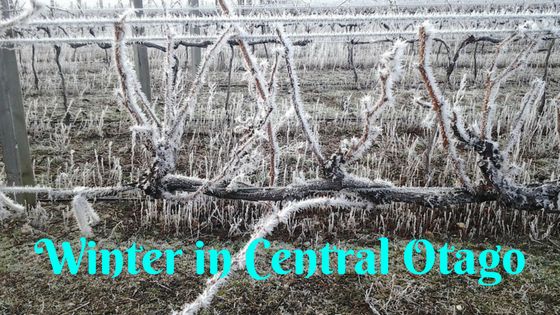
Winter in the Vineyard
As we bask in the hot days of summer here in the Northern Hemisphere, things are quite different in the Southern Hemisphere. In Central Otago, New Zealand where Twelfth Night Wine’s vineyard is located, it is the dead of winter. Essentially, seasons in New Zealand are six months ahead (or behind as the case might be) of those in the United States. July in the New Zealand yields the same weather as we have in January in Boston. And because Central Otago has a continental climate, this means there are very cold temperatures and snow. But it also means bright blue skies, lots of sunshine and beautiful snow-covered mountain peaks.
In the Vineyard
After the flurry of activity during the harvest in March and April, the action slows down dramatically in the vineyard as the vines lose their leaves and go into a period of winter dormancy. Think of it like a bear going into hibernation! The work slows down significantly as well; we go from having 30-40 part-time workers to our full-time crew of only three to four people. Julien Alexandre is our Vineyard Manager and oversees the important work of pruning and vineyard maintenance that happens during the winter months. Pruning is the most labor-intensive work during this season and is an essential part of keeping the vines healthy and prepared for the next growing season. At our vineyard, we use a method called cane pruning which entails removing extraneous canes and retaining a small number of the best ones. Canes are selected for two purposes: to provide shoots for the coming season and healthy shoots for the next dormant season. The pruned vine branches are then mulched which provides humus to regenerate the soil. All this to ensure a great growing season starting in the spring!
In the Winery
While the vineyard crew is busy with the pruning, Antony Worch, Twelfth Night’s winemaker is overseeing the many important tasks that are happening in the winery. This is the period when most of the work revolves around preparing the white and rosé wines for bottling. While red wines like Twelfth Night Pinot Noir are aged for at least nine months in French oak barrels, white and rosé wines require less aging and are normally bottled in September. Twelfth Night Riesling, Sauvignon Blanc and Rosé are all aged on the “lees” for between three and five months to give richness and complexity to the wines. This requires a process called batonnage or stirring of the lees to equally distribute them throughout the wine. At the same time, chemical analyses and adjustments to the wine including filtration and cold stabilisation are being carried out.
Careful attention is also paid to the ageing of our Pinot Noir during the winter. The most important task post fermentation is that of “topping up” the oak barrels which ensures that barrels stay completely full. Oak is porous and therefore small amounts of wine (known in winery parlance as the “Angel’s Share”) evaporate through the barrel staves and are replaced by tiny amounts of air. This evaporated wine needs to be replaced constantly in the winter to prevent oxidation and ensure that the complex flavors of the wine are maintained.
So even though winter is a time for some rest in the vineyard, lots of important work is still happening to bring you all the fabulous Twelfth Night wines you enjoy so much!







No Comments